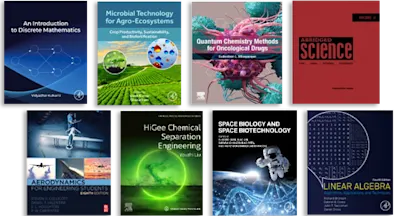
New Insights in Pediatric Holter Monitoring and Interpretation
- 1st Edition - March 1, 2026
- Latest edition
- Editors: Gabriel Cismaru, Simona Cainap, Cecilia Lazea
- Language: English
New Insights in Pediatric Holter Monitoring and Interpretation is the cutting edge book required by pediatric cardiologists and other professionals who encounter arrhythmias in chi… Read more

- Provides an organized structure for analyzing Holter ECG data in children
- Reflects the broad spectrum of frequently encountered pediatric arrhythmias, whereas other Holter ECG books are adult-focused
- Helps readers develop expertise in analyzing Holter ECGs in children of varying ages quickly and accurately using rigorous case studies
1. The beginnings of ECG Holter monitoring
2. Updated technical principles of Holter monitoring
3. New algorithms of Arrhythmia detection and signal interpretation
4. Artefacts
5. New indications of ECG Holter monitoring
6. Poincare graphs and Lorenz plots
Part II: Clinical Cases
Case 1: How to differentiate between paroxysmal supraventricular tachycardia and sinus tachycardia?
Case 2: A newborn with frequent episodes of atrial tachycardia
Case 3: Focal atrial tachycardia in a neonate
Case 4: High-burden premature ventricular contractions in a newborn
Case 5: Blocked atrial premature contractions in a newborn
Case 6: Outflow tract PVCs in a neonate
Case 7: PVCs and fusion beats in a neonate
Case 8: A 2-month-old girl with paroxysmal supraventricular tachycardia
Case 9: An 8-year-old girl with high burden PVCs
Case 10: An 8-year-old football player with asymptomatic WPW syndrome
Case 11: Low atrial rhythm in a 9-year-old girl
Case 12: Asymptomatic WPW syndrome in a 16-year-old football player
Case 13: Paroxysmal supraventricular tachycardia in a 12-year-old girl
Case 14: Two accessory pathways revealed by one Holter ECG
Case 15: Change in the nighttime distribution of PVCs after beta-blockers
Case 16: WPW syndrome with paroxysmal SVT captured on Holter ECG
Case 17: An 8-year-old girl presenting with Fascicular VT
Case 18: Benign Accessory pathway
Case 19: Sinus tachycardia in a 12-month-old boy with Prader Willi Syndrome
Case 20: A 14-year-old boy with PVCs
Case 21: Postero-septal accessory pathway with long refractory period
Case 22: Paroxysmal SVT with left bundle branch block
Case 23: A 6-year-old boy with accessory pathway
Case 24: Premature ventricular contractions with balanced distribution during daytime and nighttime
Case 25: Premature ventricular contractions with favorable response to Amiodarone but not to betablockers
Case 26: Premature ventricular contractions treated with Vitamin D
- Edition: 1
- Latest edition
- Published: March 1, 2026
- Language: English
GC
Gabriel Cismaru
Gabriel Cismaru MD, PhD is a qualified cardiologist working at the Rehabilitation Hospital Cluj-Napoca in Romania. He obtained his PhD in medicine with a research thesis on electrophysiology and pro-arrhythmic drugs. He began his electrophysiology fellowship at the Institut Lorrain du Coeur et des Vaisseaux Louis Mathieu, France, after finishing his cardiology certification in Clermont-Ferrand and Dinan, France. He began working in the Rehabilitation Hospital's Electrophysiology Laboratory in 2011. He is an experienced surgeon who implants pacemakers, CRTs, and ICDs, as well as performing catheter ablation of supraventricular and ventricular arrhythmias. He is qualified in pediatric cardiology, regularly performing device implantation and catheter ablation in children. Dr. Cismaru has authored or co-authored peer-reviewed publications and book chapters on cardiac pacing, defibrillation, electrophysiological studies, and catheter ablation. He is the author of the book Arrhythmia Induction in the EP Lab," now in its fourth edition.
SC
Simona Cainap
Dr. Simona Sorana Cainap MD, PhD is an Associate Professor in Pediatric Cardiology at the University of Medicine and Pharmacy Cluj Napoca, where she serves as an expert on pediatric cardiology, lecturers, and makes use of her extensive echocardiography competence. She is qualified as a primary pediatrician, with training in juvenile diabetes. She enjoys echocardiography, Holter monitoring, training resident doctors, and pursuing clinical work. She has received a vast amount of additional training, and has published widely in peer-reviewed journals.
CL
Cecilia Lazea
Cecilia Lazea MD, PhD is a Associate Professor of Pediatrics based in Cluj-Napoca, Romania. Her expertise is pediatric cardiology, and she has made significant contributions to the field through her research and clinical practice. She has explored the genetic factors involved in the development of congenital heart defects, and her research sheds light on transcription factors and signaling molecules that play crucial roles in cardiac development. She has participated in large-scale studies examining low atrial rhythm in children. Dr. Lazea evaluated circulating chitotriosidase activity in children with obesity, providing insights into potential biomarkers related to metabolic health. She also collaborated on research investigating anatomical-MRI correlations in both adults and children with hypertrophic cardiomyopathy.